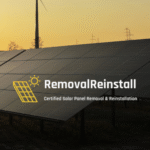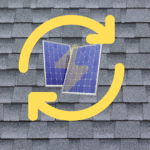What Can I Do When Removing and Reinstalling Solar Panels?
A smart time for adjustments, maintenance, and upgrades
When you replace or repair your roof, removing and reinstalling solar panels is unavoidable. But this moment can be more than logistics — it’s the perfect time to improve performance, fix issues, and make upgrades at a much lower overall cost because the system is already off the roof.
Below is a clear checklist of opportunities during removal and reinstallation (often called “detach & reset”). We include practical benefits, typical percentage gains, and examples of reputable manufacturers.
1) Inspect the Roof and Structure
- Repair leaks, soft spots, or damaged underlayment.
- Confirm deck integrity and rafter spacing for the next 25+ years.
- Re-seal all penetrations with new flashing and hardware.
Real benefit: Preventing even one extra detach & reset (often $2,000–$5,000) pays for careful inspection now.
2) Check System Production and Inverters
With panels down, run diagnostics to verify each module and the power electronics:
- Test individual module output and identify underperformers (“hot” or “cold” modules).
- Troubleshoot microinverters or optimizers; many are still within warranty.
- Replace suspect connectors and weathered junction boxes.
Real benefit: A failed inverter string or multiple microinverters can cut production by 20–30%. Brands with common long warranties include Enphase (microinverters), SolarEdge (optimizers + inverter), and SMA (string inverters). If covered, equipment costs are often $0, with you paying only labor (if any).
3) Add Extra Panels to Match Current Usage
Has your usage increased (EV, new appliances, pool pump)? Reinstall day is the cheapest time to expand:
- Optimize the roof layout for shade and spacing while everything is open.
- Add 2–4 modules to offset new loads.
Real benefit: +2 to +4 panels can add roughly 1,000–1,500 kWh/year, which is about $150–$250/year in savings (depending on local rates). Over 20 years that’s $3,000–$5,000 before rate inflation.
4) Deep Clean the Panels
Dust, pollen, and grime reduce output. Cleaning while panels are accessible ensures they go back up at peak.
Real benefit: Professional cleaning typically restores 5–15% production, worth about $50–$200/year on a typical system.
5) Upgrade the Mounting System (Switch to Rails)
Older attachments can corrode or make service difficult. During reinstallation, consider a modern rail system for straighter rows, fast maintenance, and strong weather resistance.
- New flashing and hardware reduce leak risk.
- Rails speed future service calls and module swaps.
- Better wire management keeps conductors protected.
Real benefit: Because the array is already down, a rail upgrade often costs 20–30% less than a stand-alone project. Trusted brands include IronRidge and Unirac.
6) Replace the Small Parts That Matter
Certain components should not be reused for safety and warranty reasons:
- Roof flashing, seals, and attachment hardware
- UV-brittle wire clips and zip ties; damaged MC4 connectors
- Compromised junction boxes, conduit fittings, and grommets
Real benefit: Fresh waterproofing and wire management reduces nuisance faults and leak risk, protecting your roof and electronics long-term.
7) Add Affordable, High-Impact Efficiency Upgrades
Solar Attic Fan
- Lowers attic temperature by about 10–15°F in hot months.
- Typical cooling bill reduction: ~10–12% in warm climates.
Hybrid Solar Pool Heater
- Reduces pool heating energy by 50–70%.
- Extends swim season with minimal operating cost.
Real benefit: These add-ons frequently pay back in 2–4 years, especially when installed while crews are already mobilized.
8) Consider a Battery (Backup & Independence)
A home battery doesn’t just “save money” — it adds resilience, time-of-use control (where applicable), and energy independence.
- 10 kWh class batteries (e.g., Tesla Powerwall, Enphase IQ Battery, LG Chem) typically cover 8–12 hours of essential loads.
- Pairs well with solar monitoring to prioritize critical circuits.
Real benefit: Keep essentials on during grid outages, increase self-consumption, and potentially time-shift loads if your utility has peak pricing.
9) Preventive Maintenance Checklist Before Re-Energizing
- Megger/insulation checks on home-run conductors (as required).
- Verify grounding, bonding, and rapid shutdown compliance.
- Replace worn seals and torque all mechanical fasteners to spec.
- Labeling and placards updated per current code.
- Recommission monitoring (app/portal) and confirm live data.
Real benefit: Solid PM reduces nuisance trips and extends useful life by 5–10 years across components.
10) Permits, HOA, and Warranty Notes
- Some jurisdictions require permits for detach & reset or upgrades.
- If engineering plans are required and you don’t have originals, new plans can be provided (additional cost in many areas).
- Using licensed, insured, manufacturer-certified pros (e.g., Tesla, Enphase, SolarEdge) helps keep warranties intact.
For general, authoritative guidance, see the U.S. Department of Energy’s overview of solar technologies and best practices: DOE – Solar Energy Technologies Office.
FAQs
Are inverter fixes usually covered?
Often yes. Many microinverters/optimizers/inverters carry 10–25 year warranties. You may only pay labor or shipping, if anything, subject to the manufacturer’s policy.
Is this a good time to switch to rails?
Yes. With panels off the roof, a rail upgrade typically costs 20–30% less than doing it later.
Can I add a few panels now and more later?
Absolutely. It’s common to add 2–4 now to cover new loads, then revisit if your usage changes again.
Conclusion
Don’t treat removal and reinstallation as a hassle treat it as an upgrade window. Clean the modules, fix any underperformers, consider a rail system, add a few panels, install a solar attic fan or a hybrid pool heater, and think about a battery for resilience. The result is a safer, cleaner installation with higher production, better serviceability, and long-term savings.



